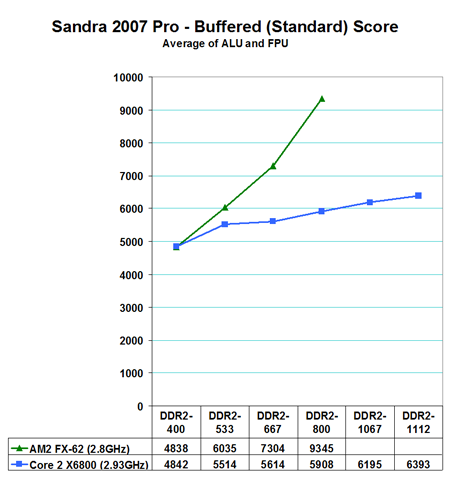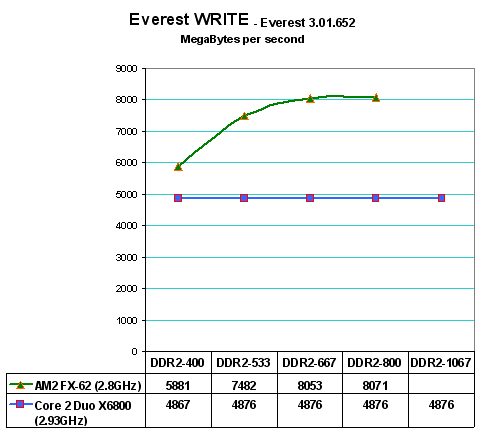Memory Bandwidth and Scaling
Everyone should already know that memory bandwidth improves with increases in memory speed and reductions in memory timings. To better understand the behavior of AM2 and Core 2 Duo memory bandwidth we used SiSoft Sandra 2007 Professional to provide a closer look at memory bandwidth scaling.

The most widely reported Sandra score is the Standard or Buffered memory score. This benchmark takes into account the buffering schemes like MMX, SSE, SSE2, SSE3, and other buffering tools that are used to improve memory performance. As you can clearly see in the Buffered result the AM2 on-chip memory controller holds a huge lead in bandwidth over Core 2 Duo. At DDR2-800 the AM2 lead in memory bandwidth is over 40%.
As we have been saying for years, however, the Buffered benchmark does not correlate well with real performance in games on the same computer. For that reason, our memory bandwidth tests have always included an UNBuffered Sandra memory score. The UNBuffered result turns off the buffering schemes, and we have found the results correlate well with real-world performance.

The Intel Core 2 Duo and AMD AM2 behave quite differently in UNBuferred tests. In these results AM2 and Core2 Duo are very close in memory bandwidth - much closer than in Standard tests. Core 2 Duo shows wider bandwidth below DDR2-800, but this will likely change when the AM2 controller matures and supports values below 3 in memory timings as the Core 2 Duo currently supports.
The Sandra memory score is really made up of both read and write operations. By taking a closer look at the Read and Write components we can get a clearer picture of how the two memory controllers operate. Everest from Lavalys provides benchmarking tools that can individually measure Read and Write operations.

The READ results are particularly interesting, since you can see that the READ component of Core 2 Duo performance is much larger than the WRITE results on Core 2 Duo. This is the result of the intelligent read-aheads in memory which Intel has used to lower the apparent latency of memory on the Core 2 Duo platform. Actual READ performance on Core 2 Duo now looks almost the same as AM2 to DDR2-533. AM2 starts pulling away in READ at DDR2-677 and has a slightly steeper increase slope as memory speed increases. The increases in READ speed in Core 2 Duo are a result of the intelligent read-aheads in memory. Performance without this feature would show Core 2 Duo much slower in READ operations than AM2.

This is most clearly illustrated by looking at Everest Write scores. Memory read-ahead does not help when you are writing memory, so core 2 Duo exhibits much lower WRITE performance than AM2 as we would expect. This means if all else were equal (and it isn't) the AM2 would perform much better in Memory Write tasks. Surprisingly the WRITE component of Core 2 Duo appears a straight line just below 5000 MB/s. AM2 starts at 5900 at DDR2-400 and WRITE rises to around 8000MB/s at DDR2-667. Write then appears to level off, with higher memory speeds having little to no impact on AM2 WRITE performance.
Everyone should already know that memory bandwidth improves with increases in memory speed and reductions in memory timings. To better understand the behavior of AM2 and Core 2 Duo memory bandwidth we used SiSoft Sandra 2007 Professional to provide a closer look at memory bandwidth scaling.

The most widely reported Sandra score is the Standard or Buffered memory score. This benchmark takes into account the buffering schemes like MMX, SSE, SSE2, SSE3, and other buffering tools that are used to improve memory performance. As you can clearly see in the Buffered result the AM2 on-chip memory controller holds a huge lead in bandwidth over Core 2 Duo. At DDR2-800 the AM2 lead in memory bandwidth is over 40%.
As we have been saying for years, however, the Buffered benchmark does not correlate well with real performance in games on the same computer. For that reason, our memory bandwidth tests have always included an UNBuffered Sandra memory score. The UNBuffered result turns off the buffering schemes, and we have found the results correlate well with real-world performance.

The Intel Core 2 Duo and AMD AM2 behave quite differently in UNBuferred tests. In these results AM2 and Core2 Duo are very close in memory bandwidth - much closer than in Standard tests. Core 2 Duo shows wider bandwidth below DDR2-800, but this will likely change when the AM2 controller matures and supports values below 3 in memory timings as the Core 2 Duo currently supports.
The Sandra memory score is really made up of both read and write operations. By taking a closer look at the Read and Write components we can get a clearer picture of how the two memory controllers operate. Everest from Lavalys provides benchmarking tools that can individually measure Read and Write operations.

The READ results are particularly interesting, since you can see that the READ component of Core 2 Duo performance is much larger than the WRITE results on Core 2 Duo. This is the result of the intelligent read-aheads in memory which Intel has used to lower the apparent latency of memory on the Core 2 Duo platform. Actual READ performance on Core 2 Duo now looks almost the same as AM2 to DDR2-533. AM2 starts pulling away in READ at DDR2-677 and has a slightly steeper increase slope as memory speed increases. The increases in READ speed in Core 2 Duo are a result of the intelligent read-aheads in memory. Performance without this feature would show Core 2 Duo much slower in READ operations than AM2.

This is most clearly illustrated by looking at Everest Write scores. Memory read-ahead does not help when you are writing memory, so core 2 Duo exhibits much lower WRITE performance than AM2 as we would expect. This means if all else were equal (and it isn't) the AM2 would perform much better in Memory Write tasks. Surprisingly the WRITE component of Core 2 Duo appears a straight line just below 5000 MB/s. AM2 starts at 5900 at DDR2-400 and WRITE rises to around 8000MB/s at DDR2-667. Write then appears to level off, with higher memory speeds having little to no impact on AM2 WRITE performance.










118 Comments
View All Comments
duploxxx - Thursday, July 27, 2006 - link
please give us edit...powerconsumption is only less in 100% load.... when powermode kicks in the amd is much less consuming... how long do you think a system runs in powermode against full load....
duploxxx - Thursday, July 27, 2006 - link
wrong... the conroe gains from the memory speed the amd more thats a fact... the ones you are referring to are probably 4200 and 5000, well we can say that they perfrom better when using 533/667 because then they don't have the devider issue running the memory on 742 in stead of 800.so the performance/price ratio on those chips is better with 553/667
zsdersw - Thursday, July 27, 2006 - link
Conroe's performance isn't merely a function of memory bandwidth or memory speed.PeterR - Tuesday, July 25, 2006 - link
If you could actually go out and BUY one ?Peter R.
michal1980 - Tuesday, July 25, 2006 - link
Wow. AMD fanboi's pulling out all the crap that the intel fanboi's have pulled in the past.wake up!. Right now, Intel core 2 duo is faster then AMD 64 right now.
Its like video card fanboi's but worse, because the difference here is clear.
If I was building a gaming rig this year, I would build with a core 2 duo.
Just like a few months ago, it would be with an AMD 64.
I go with what company is faster. I used both nvidia cards, and ati Cards. I use pentiums, and p2's, I used athlon xp's when you over clock them 50% ease and they were dirt cheap. I use a opty dual core right now because it was faster then the p4's. I use p-m lappys because of performance/battery life.
If I was building a rig right now. I'd switch to an intel Core 2 duo. Why? because its faster. I could care less about who makes it.
if apple comes out tommorow with a magic pc that runs all pc games run 20% faster, I'm buying an apple.
Pirks - Tuesday, July 25, 2006 - link
I'd buy a iMac or Mac Pro right this second if it were running all PC games at all without rebooting between OS X and XP.yacoub - Tuesday, July 25, 2006 - link
Two things:1 - I think I like the new font used in tables and charts.
2 - In the SuperPi chart you say Lower is Better but then inverse the graph such that it is actually the line higher on the graph that is better. Unless the reader looks closely at the numbers, they could infer that the AMD chip wipes the floor with the Conroe.
redbone75 - Tuesday, July 25, 2006 - link
Seriously, though, here we have a completely new architecture from Intel, the same Intel that is this massive company with enormous resources and huge R&D departments, and these AMD fanboys are still all upset because Intel has not only achieved parity with but also exceded AMD in performance. Come to think of it, this is the exact same argument that AMD fans were using when preliminary benchmarks came out on Conroe. "It's not fair to compare Intel's new architecture to AMD's old one, because they have an advantage." Hey, you want some cheese with that wine? I'll tell you what: AMD enjoyed the performance lead for a while. Now, Intel is having a go at it and, with any luck, AMD will come out on top in the future, at least I really hope so. Why do I hope so? Do any of you think AMD would have lowered their processor prices so much if Conroe wasn't such a threat? Do you think Intel would have released Conroe at these prices if they didn't have to take back the crown from AMD? Hey, with the X2's we still get a great range of processors at much lower prices. Hell, even the Pentium D's are going to be attractive at lower prices. That makes me happy, not some benchmarks saying this processor is faster than that processor. And really, I don't know about you but I don't care about which processor wins memory latency benches, I only care about the end performance in applications I actually use.DigitalFreak - Tuesday, July 25, 2006 - link
Amen, brother!TravelMug - Tuesday, July 25, 2006 - link
As said by several people before - you are not testing latency but the prefetch abilites of the CPU. Same has been said about the original Conroe article, you don`t seem to listen though."Everest from Lavalys shows latency improvements in the new CPU revisions, but it shows Latency more as we would expect in evaluating Conroe. For that reason, our detailed benchmarks for latency will use both Everest 1.51.195, which fully supports the Core 2 Duo processor, and ScienceMark 2.0."
Really? That is a 2 years old version, there have been countless new version since then. Also, if that version "fully supports" the Core 2 Duo processor, how come this is what the developer says about the latest version 3.01?:
http://www.lavalys.com/products/whatsnew.php?pid=3...">Support for Intel Core 2 "Conroe" and "Merom" processors